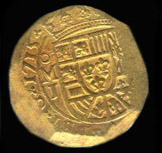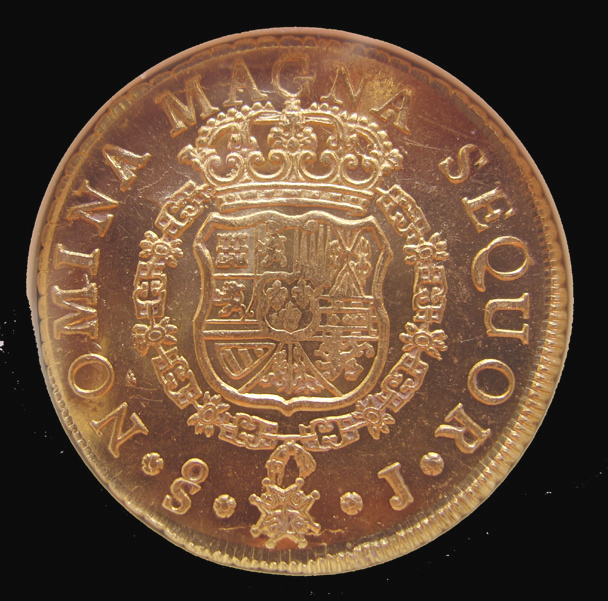 |
|
|
|
|
||
|
Latest News "Essential Books" Click here
|
PORTRAIT GOLD OF THE SPANISH AMERICAS (1732-1824)
(updated
May, 2009)
If you are unfamiliar with the Lima Portrait onza series, here is brief introduction to the 13 major types it comprises. A brief introduction to the 5 types of Potosi onzas is here. Mexico and the Colombian mints coming soon.
A brief word about condition rarity, if I may. Some of you come to Spanish Colonial onzas with a background in collecting early US gold. Every type and almost every date of early US eagles & half eagles is represented by a few choice mint state coins. For the most part these coins were set aside and saved at the time of issue by early collectors or mint officials, and have passed through distinguished collections ever since. None of this happened with Spanish Colonial onzas. No eager collectors besieged the colonial mints for choice specimens. No proofs were ever requested or struck for milled onzas. Colonial onzas went straight into circulation and often remained there for over a 100 years. The result is that the majority of dates and even some types are now unknown in mint state or even choice AU. The condition census for quite a few key types is comprised of series of about EF and VF. Look at the photos in Calico and in the major auctions. A few common date in the era of Carlos III do offer a supply of uncirculated onzas, but a "supply" of Colonial onzas is 4-6 coins! Please readjust your thinking about condition rarity when you come to Colonial onzas: all mint state Colonial onzas are rare and many types are lucky to exist in EF.
Lima. 8 escudos of Ferdinand VI. 1751 J. Choice AU. One of only two 1751 Lima onzas recovered from la Nuestra Senora de la Luz. Very rare as such. From Castells & Castells Luz auction in Montevideo in Nov 1991, lot 133, with original photocertificate and catalogue.
This wonderful shipwreck coin was one that I mail-bid on in the November 6th, 1997 Castells & Castells auction held in Montevideo. I thought my princely bid of $4250 (net) would easily win this beauty. It rose quickly in the bidding to $4825. I was disconsolate! Unlike Santiago 1751 onzas and Lima cob onzas 1749-50, which were both recovered in some numbers from the Luz, exactly two Lima 1751 eight escudos were found on the wreck. That was the number Ruben Collado reported in 1992, that was number repeated at this sale, and in the ensuing 11 years no other specimens have appeared or even been rumored. I conclude the TWO Lima 1751 were found on the Luz, making it the key gold coin to collecting this ever more popular 1752 wreck.
This coin was one of the highlights of the auction and was colored-plate on page 31 of the catalogue. The original photo-certificate that Senors Castells & Collado prepared for the better gold pieces accompanies the coin. I will enclose a color copy of plate and of the historical sections of the catalogue. The catalogue has itself become rare and collectible, and regrettably I have only my own annotated copy. I will enclose a copy of the Sotheby's 1992 Luz catalogue for those who wish to read about the wreck and its numismatic treasure.
Now available for $5450.
(If you are unfamiliar with the Lima Portrait onza series, here is brief introduction to the 13 major types it comprises.) ***********************************************************************************
From the wreck of Nuestra Senora de la Luz, a choice mint state 1751 J Santiago eight escudos. High-relief with very deep prooflike fields, a Proof-quality specimen. The finest known 1751 Santiago and the only one graded MS64 by NGC (none higher). One of the most attractive Spanish Colonial portrait onzas I have ever seen.
The decline of Spanish power in the Pacific and Caribbean meant that by the mid-18th century gold for the Spanish crown was often transshipped across South America and embarked for Spain at Buenes Aires, Montevideo or other Eastern ports. Because of the tragic loss of Nuestra Senora de la Luz in Montevideo harbor in July 1752, we have a window on the beginnings of coinage at the new Santiago mint and the final cob coinage at Lima. Without the treasure of the Luz, most of these issues would be known only from literary sources or from a few well worn examples. Among the treasure of the Luz was a shipment of new 1751 Santiago onzas. When Ruben Collado salvaged the Luz in 1992-93, he made a study of the Santiago onzas, before dividing the treasure between two large public sales and some private sales. This coin is from a die combination Collado calls M/7 (see the Sotheby's catalogue for the diagnostics of the varieties). Like most of the best Santiagos, this one was sold privately by Collado in 1993 and resided in a large private collection until making a recent trip to NGC.
I have seen hundreds of Santiago 1751 onzas from the wreck of Nuestra Senora de la Luz, including the Sotheby's coins offered in March 1993. Almost all fall in the AU55- MS61 range, held back by poor strikes (especially on the bust of Ferd VII) and by sea corrosion. For reasons not yet understood, the new mint at Santiago decided to strike their onzas in high relief and on polished planchets. In a word, in proof quality! Like our own experiment with high-relief gold in 1907, the Santiago mint's noble experiment soon proved impractical. Most onzas came off the dies with poor strikes on one or both sides. Government officials complained about the ugly, flatten bust of Ferdinand, and by 1752 the mint went back to striking onzas with normal relief. But among the onzas of 1751, those few that did come off the dies with full strike remain perhaps the most attractive gold issue of the Spanish Americas.
Sea corrosion hurts the Santiago onzas principally by darkening their highly reflective fields. The deep prooklike surface remains visible in the sheltered areas of the legends, the open fields especially around Ferdinand are dull and dark. This darkening effect unfortunately besets and impairs some onzas with superior strikes. A very few coins, then, came off the dies at Santiago with full strikes and deep fields and then miraculously survived 240 years at the bottom of Montevideo harbor.
Three or four 1751's stand out in my mind. A deep prooflike coin similar to this one, but baggier and graded an MS63, bought $8050 at a Heritage auction in Sept 2007. Another very choice coin, not quite as prooflike and graded MS 63, brought $7500 in a private mid-2008 sale. Another NGC MS 63, now offered below, is its twin. The 1751 offered above is a level above these coins. My photos do not do it justice. Proof gold photographs poorly. If you've collected Proof US Liberty Double Eagles, you know what I mean. For the collector of Spanish Colonial who wants the best, this is the coin.
Now available. $7750.
********************************************************************
From the wreck of Nuestra Senora de la Luz, another very deep prooflike, high-relief, choice mint state 1751 J Santiago eight escudos, second only to the specimen above, but another example of the most attractive Spanish Colonial portrait onzas ever produced.
NGC in their wisdom have decided that this spectacular piece of LUZ gold is only a MS 63. Were this a $20 US Liberty, it would be graded a MS 65 DPL. But let that pass. It has very clean and very deep mirror surfaces, with thehigh relief of a modern proof. My photos do not do it justice.
Available with a 1993 Sotheby's catalogue, explaining the coinage recovered from Nuestra Senora de la LUZ. SOLD.
POTOSI. Eight Escudos of Carlos IV with portrait of Carlos III. 1790/89 PR. Numeral IV over III. "Extremely rare" (Calico) transitional issue. Key to the Potosi Gold series. Cal. OMB 1306 Choice EF or better. One of the finest known. Encapsulated and Graded EF45 by ANACS
Discovered in 1545, the Cerro Rico looming over the town of Potosi (in modern Bolivia) was the site of the richest silver mine in the New World. Beginning in 1574 the Spanish Colonial mint at Potosi issued a prolific cob coinage in silver, but no gold cobs were ever struck. After the Colonial reorganization of 1776, Potosi became the sole mint of the new Viceroyalty of Rio de la Plata. In 1778 Potosi began to strike its first gold coins. When the reigning monarch Carlos III died in 1788, Potosi faced the problem of having no portrait punches for the new king. The remedy settled upon was to continue striking gold using old Carlos III dies, but with the ordinal of the king changed from III to IV. This the Potosi assayers did in 1789, and again very early & briefly in 1790, with one overdated 1789 die, while they awaited the portrait dies of Carlos IV that finally arrived mid-January.
The transitional issue of 1789 and 1790/89 was very small, and few specimens in any condition survive. No mint state coin , or even choice AU, coin is known. Calico calls the transitional issues 1305 and 1306 "extremely rare." Without question they are the key type for the Potosi Gold Series. The 1790/89 illustrated in Calico's LA ONZA is a softly struck choice VF/about EF. Major collections such as Millennia lack the transitionals entirely. The big-dollar Karon Collection had to make do with a "dull, about EF" specimen (lot 47, which realized $4620 in December of 1992). Eliasberg (lot 1028) had a horrible looking coin that not even NCS conservation could make collectible. Another badly impaired 1790/89 with deep cuts across the portrait and shield recently auctioned and then resold for nearly $2000. For another comparison, a rare, but by no means as rare, 1791 Potosi in cleaned VF condition recently went for $4000.
This is a very attractive Potosi onza. The distinctive "semi-rat-nose" portrait of Carlos III is very bold, and the Bourbon shield is well struck and without any of the usual planchet problems. The coin shows light high point wear, but it has luster---something never seen on any transitional! A little toning is found on the obverse and Carlos' portrait has some minor weakness along the neck, but this is unavoidable on the worn and reused the 1789 die. Certainly this is one of the finest, if not the finest, of the Carlos IV Potosi transitionals.
Enlargements of the 90/89 overdate and IV/ III numeral below. I apologize for the poor quality of the images. Photographing encapsulated coins is very challenging. Suggestions welcome from anyone who has mastered that art. For those of you who would like to learn more about the types and rarity of Potosi onzas, here is a brief introduction to the series.
terravitan@aol.com or 480-595-1293
©2007 Goldcobs.com All Rights Reserved.
(Reserved space for
future pieces)
©2007 Goldcobs.com All Rights Reserved.
|








